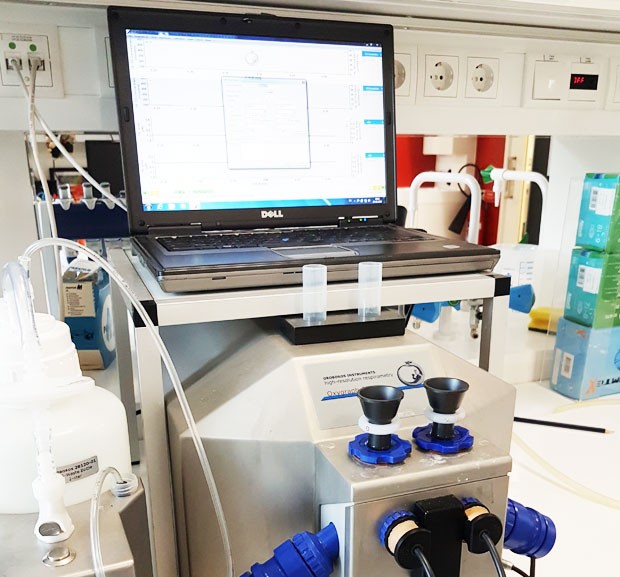Researcher investigates the causes of cardiovascular disease

While it seems that everyone cares about matters of the heart around Valentine’s Day, researchers at the Concordia Cardiovascular Lab (also known as the Bergdahl Lab) investigate them all year long.
Overseen by Andreas Bergdahl, associate professor in the Department of Exercise Science, the lab focuses on various aspects of blood flow regulation, including how the pumping heart propels oxygenated blood through the body.
One of the lab's researchers, master's student Chelsea D’Abreau, is trying to understand why heart size varies in response to altered plasma lipid levels.
Previous research has suggested sex, age, hypertension, obesity, and a patient’s history of heart attacks could all be factors that contribute to hypertrophy.
But independent of any of these, it has also been reported that people with an abnormal amount of lipids, a condition called “dyslipidemia,” have the same condition.
In the lab, D’Abreau and Bergdahl have observed a notable difference in heart size when comparing mice that have augmented plasma lipid levels. The mechanism responsible for this occurrence remains unknown — so far.

‘We want to establish whether lipids drive the increase in heart size’
How does this specific machine (above) relate to your research at Concordia?
It’s an oxygraph, which is a polarographic oxygen sensor that allows us to analyze oxygen consumption and adenosine triphosphate (ATP) production, which is an organic chemical and source of mitochondrial energy involved in cellular respiration. That makes it a formidable tool in characterizing mitochondrial respiration.
The approach permits analysis of functional capacities in individual mitochondrial complexes, and with the oxygraph we are able to determine whether or not the heart is utilizing substrates at optimal levels. Ultimately, the oxygraph aids in establishing whether larger heart size is caused by a shift in ATP production.
What is the hoped-for result of your project? And what impact could you see it having on people's lives?
Cardiovascular disease in on the rise. At this point in time, we believe that a dyslipidemic environment, which alters coupling between oxidation and phosphorylation in cardiac mitochondria, leads to hypertrophy of the heart.
The hoped-for result of this project is to gain some insight into whether lipids themselves, or a damaging production of reactive oxygen species, drive the increase in heart size and how this phenomenon ultimately contributes to heart failure.
What are some of the major challenges you face in your research?
Due to the nature of the cardiovascular research being performed in the Bergdahl Lab, we cannot use human tissue to conduct our experiments, as human heart donations are scarce.
As a result, the major challenge we face is in explaining that our research performed on rodent subjects is applicable to humans. The heart muscle cells of rodents and human react the same way in response to stress, various nutrients and exercise.
What are some of the key areas where your work could be applied?
Our work can be applied in clinical settings in treatment processes for diabetes and dyslipidemia. The information derived from this study holds the potential to expand the existing knowledge concerning the physiological pathways that cause the heart to become susceptible to certain pathologies. With this, future research can target prospective treatment.
What person, experience or moment in time first inspired you to study this subject and get involved in the field?
To be honest, just the thought of a thesis-based master’s degree scared the bejesus out of me. I wasn’t sure if I was ready to tackle such a big responsibility on my own. However, prior to submitting an application, I contacted Dr. Bergdahl to ask if I could volunteer in his research lab.
The atmosphere was a breath of fresh air. It was like he immediately knew what my fear was and reassured me that I was not on my own, and that we are a team. The Bergdahl Lab is a friendly and supportive environment.
How can interested STEM students get involved in this line of research? What advice would you give them?
Get involved beforehand – volunteer, participate in ongoing research projects, get to know your peers and professors. Find what interests you, and go for it! Word of advice: Research is not for the faint of heart. Know what you are getting yourself into. You have to be ready to fall numerous times and get right back up again. When you are finally successful, it is the most rewarding and exciting feeling.
What do you like best about being at Concordia?
Concordia is like a second home to its students. You feel welcome, comfortable and at ease each time you enter the premises. Whenever I am working in the lab or the Animal Care Facility, all other stresses and headaches in my life disappear.
Concordia is my escape. Whatever you need, ranging from help with course material to chatting about the much-anticipated Super Bowl, someone is there for you. Being a student here promises immeasurable education, worthwhile experiences, and friendships that persist beyond the university’s walls.
Are there any partners, agencies or other funding/support attached to your research?
This project is in collaboration with the Xlab Group at the University of Copenhagen in Denmark. I received a Concordia Merit Scholarship from the university when I started my master’s degree this past fall, September 2017.
Find out how to mend a broken heart from Concordia's Andreas Bergdahl.
Find out more about the Concordia Cardiovascular Lab.


